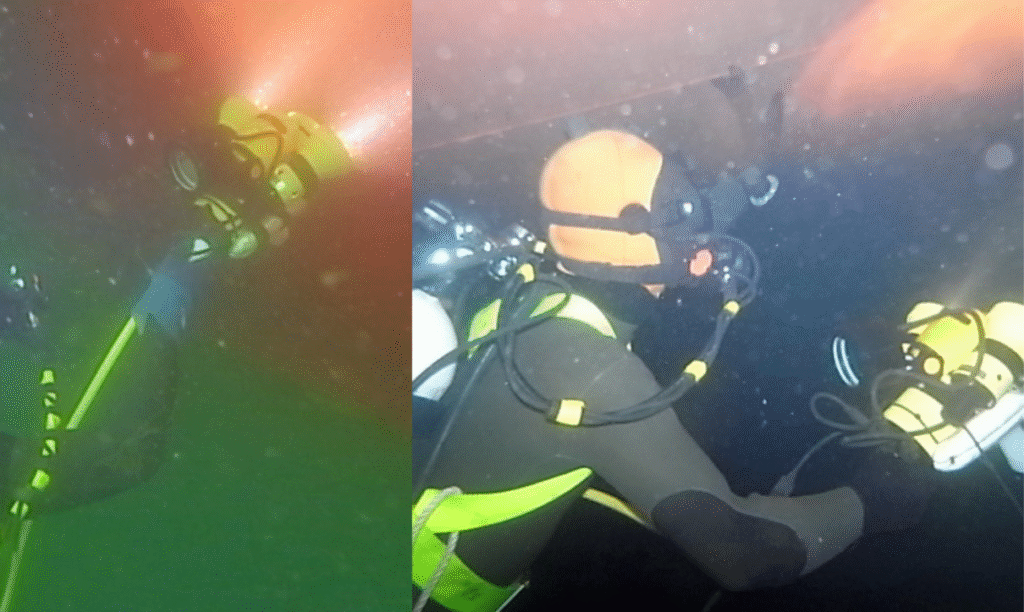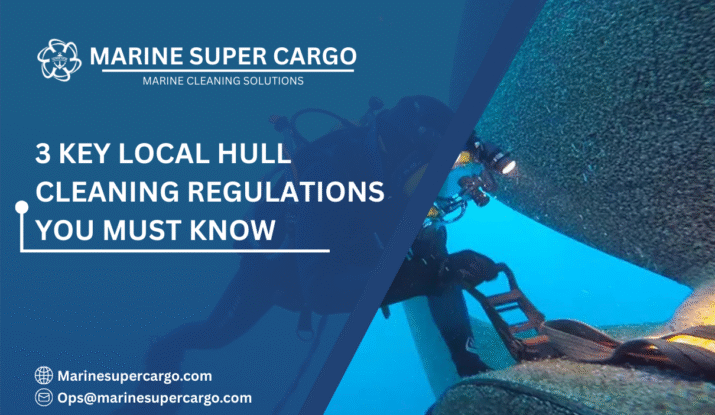Hull cleaning is an essential aspect of vessel maintenance, but complying with local rules can be complex. The United States, European Union, and Asia-Pacific countries have developed distinct frameworks to control environmental impact, manage invasive species, and prevent pollution from in-water hull cleaning. Understanding local hull cleaning regulations ensures that ship owners, operators, and environmental managers maintain compliance, avoid penalties, and promote sustainability while optimizing operational efficiency.
In-water hull cleaning can release biofouling organisms, paint particles, and chemical residues into surrounding waters. Without proper containment, these discharges can disrupt ecosystems, spread invasive species, and violate environmental laws. Zero-discharge systems and specialized filtration are becoming essential to comply with modern regulations.
Why Local Hull Cleaning Regulations Are Critical
Consider arriving at a busy port after a long voyage only to be informed that your cleaning methods violate local rules. The consequences could include fines, delayed docking, or reputational damage. Local Hull Cleaning Regulations exist to protect marine environments, maintain safety, and support global shipping standards.
The main reasons these regulations matter include:
- Environmental Protection: Reduces the release of toxic substances such as copper and zinc from antifouling paints.
- Biosecurity Control: Prevents the spread of invasive species that can disrupt local ecosystems.
- Regulatory Compliance: Aligns with IMO biofouling guidelines and MARPOL discharge requirements.
- Operational Efficiency: Minimizes maintenance costs and avoids costly port detentions.
By understanding regional variations, operators can plan cleaning schedules, choose suitable methods, and reduce environmental and legal risks.

US Hull Cleaning Regulations
In the United States, hull cleaning is regulated at both the federal and state levels. The Environmental Protection Agency (EPA) provides overarching guidelines, while states like California and Washington implement stricter standards due to environmentally sensitive areas.
Key points include:
- Chemical Restrictions: Certain antifouling coatings with copper or biocides are regulated, and any paint debris or chemical discharge must follow strict containment protocols.
- Permit Requirements: In-water hull cleaning often requires permits, especially in sensitive coastal zones. Operators must submit plans detailing waste capture and disposal methods.
- Regional Variations: California enforces zero-discharge or full containment rules, while other states may allow controlled discharge under strict conditions.
Using certified contractors such as CleanShip.co ensures compliance by employing vacuum suction systems and multi-stage filtration during cleaning operations. Proper documentation is critical to meet EPA inspections and avoid fines.
European Union Hull Cleaning Regulations
The European Union enforces stringent environmental standards for hull cleaning under frameworks such as the Water Framework Directive (WFD) and the Marine Strategy Framework Directive (MSFD). Local Hull Cleaning Regulations in the EU focus on zero-discharge practices and high biosecurity standards. Learn more.
Important aspects include:
- Zero-Discharge Enforcement: Many ports prohibit direct discharge of cleaning residues, especially paint particles and antifouling chemicals.
- Port-Specific Approval: Individual ports may require pre-approval for cleaning operations and detailed operational plans.
- Biosecurity Measures: Strict monitoring and containment of hull fouling organisms are mandatory to prevent invasive species transfer.
Operators increasingly rely on autonomous cleaning robots or remotely operated vehicles (ROVs) with onboard filtration to comply with EU rules while maintaining efficiency. IMO guidance and MARPOL Annex V principles are integral to the regulatory framework.
Asia-Pacific Hull Cleaning Regulations
The Asia-Pacific region presents a diverse regulatory landscape, with varying approaches depending on the country. Nations such as Australia, Singapore, Japan, and China have distinct Local Hull Cleaning Regulations aimed at balancing economic growth with environmental protection.
Highlights include:
- Australia: Biosecurity is prioritized under the Biosecurity Act, requiring full containment of cleaning residues to prevent invasive species introduction.
- Singapore: In-water cleaning is permitted only under controlled conditions with zero-discharge systems, and authorities conduct regular inspections.
- Japan and China: While regulations are still evolving, major ports are adopting IMO-compliant biofouling guidelines and mandating documented cleaning protocols.
Compliance in Asia-Pacific often involves approval of cleaning equipment, detailed documentation, and environmental monitoring.
✅ 4 Things to Check for Safety at Sea pic.twitter.com/dAxhJQ2i6U
— Marine Super Cargo (@Marinsupercargo) September 14, 2025
Comparative Overview of Regional Regulations
For operators navigating multiple regions, understanding regulatory differences is critical. Here’s a summary:
| Region | Chemical Discharge | Biosecurity | Permits & Approvals | Preferred Methods |
|---|---|---|---|---|
| US | Controlled, region-specific | Medium | Required in sensitive zones | Diver-assisted suction, filtration |
| EU | Strict zero-discharge | High | Port-specific approval | ROV, autonomous systems, filtration |
| Asia-Pacific | Varies by country | Medium-High | Mandatory documentation | Zero-discharge, filtration, ROVs |
By analyzing these differences, operators can standardize cleaning protocols while ensuring compliance and minimizing environmental impact.
Compliance Strategies for Ship Operators
To ensure adherence to Local Hull Cleaning Regulations, operators should adopt strategic approaches:
- Plan: Review local and international rules before scheduling cleaning operations.
- Use Certified Contractors: Partner with services like CleanShip.co that implement zero-discharge methods and maintain records.
- Invest in Technology: Utilize ROVs, autonomous robots, and filtration systems to meet regulatory requirements efficiently.
- Monitor and Record: Maintain detailed logs of cleaning operations for inspections and audits.
- Train Crew: Ensure personnel are familiar with regulations, safety procedures, and environmental responsibilities.
Proactive compliance reduces fines, delays, and reputational risks while supporting sustainable operations.
Environmental and Financial Benefits
Adhering to Local Hull Cleaning Regulations offers multiple advantages:
- Protects Marine Ecosystems: Prevents chemical pollution and the spread of invasive species.
- Improves Fuel Efficiency: Cleaner hulls reduce drag, resulting in lower fuel consumption.
- Reduces Costs: Avoids penalties, minimizes coating damage, and reduces emergency maintenance.
- Demonstrates Corporate Responsibility: Shows commitment to sustainable shipping practices.
Using zero-discharge and certified cleaning methods maximizes both environmental and operational benefits.

Future Trends in Local Hull Cleaning Regulations
Local Hull cleaning regulations continue to evolve with technology and environmental awareness:
- Global Alignment: IMO biofouling guidelines are increasingly influencing national regulations.
- Technology Adoption: Ports are implementing ROVs, autonomous cleaning robots, and advanced filtration systems to enforce zero-discharge compliance.
- Data-Driven Compliance: Environmental monitoring, reporting tools, and sensor networks are becoming standard to track cleaning effectiveness.
- Sustainability Incentives: Some ports provide reduced fees or priority docking for vessels following strict zero-discharge practices.
Keeping updated with regulatory changes helps operators maintain compliance and a competitive edge.
Conclusion
Understanding Local Hull Cleaning Regulations across the US, EU, and Asia-Pacific is vital for sustainable, compliant, and efficient shipping. Key takeaways:
- Regulations vary widely; the EU is the strictest, and Asia-Pacific standards are evolving rapidly.
- Compliance protects the environment, prevents fines, and improves operational efficiency.
- Leveraging zero-discharge methods and certified contractors ensures safe, sustainable hull cleaning.
Partnering with CleanShip.co provides reliable solutions for regulatory compliance, environmental protection, and cost efficiency.
FAQs:
Q1. What are local hull cleaning regulations?
Rules set by regional authorities that govern in-water hull cleaning to prevent pollution and invasive species spread.
Q2. Why do regulations differ between regions?
Environmental sensitivity, national laws, and port-specific requirements create variations in standards.
Q3. How can ship operators comply?
By using certified contractors, zero-discharge systems, proper documentation, and trained crews.
Q4. Do these regulations affect operational costs?
Yes, but they also save money by reducing fines, fuel consumption, and maintenance costs.
Q5. Are zero-discharge systems mandatory?
Increasingly, yes. Many EU and Asia-Pacific ports require zero-discharge practices for compliance.


